Royal court

Aroyal court,often called simply acourtwhen the royal context is clear, is an extendedroyal householdin amonarchy,including all those who regularly attend on amonarch,or another central figure. Hence, the wordcourtmay also be applied to thecoterieof a senior member of thenobility.Royal courts may have their seat in a designated place, several specific places, or be a mobile,itinerant court.
In the largest courts, the royal households, many thousands of individuals constituted the court. Thesecourtiersincluded the monarch or noble'scamarillaandretinue,household, nobility,clergy,those withcourt appointments,bodyguards,and may also include emissaries from other kingdoms or visitors to the court.Foreign princesand foreign nobility inexilemay also seek refuge at a court.
Near EasternandFar Easterncourts often included theharemandconcubinesas well aseunuchswho fulfilled a variety of functions. At times, the harem was walled off and separate from the rest of the residence of the monarch. InAsia,concubines were often a more visible part of the court. Lower rankingservantsand bodyguards were not properly called courtiers, though they might be included as part of the court or royal household in the broadest definition. Entertainers and others may have been counted as part of the court.
Patronage and courtly culture
[edit]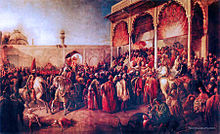
Aroyal householdis the highest-ranking example ofpatronage.Aregentorviceroymay hold court during the minority or absence of the hereditary ruler, and even an electedhead of statemay develop a court-like entourage of unofficial, personally-chosen advisers and "companions". The French wordcompagnonand its English derivation "companion" literally mean a "sharer of the bread" at table, and a court is an extension of the great individual's household. Wherever members of the household and bureaucrats of the administration overlap in personnel, it is reasonable to speak of a "court", for example inAchaemenid Persia,Ming China,Norman Sicily,thepapacybefore 1870 (see:papal household), and theAustro-Hungarian Empire.A group of individuals dependent on the patronage of a great man, classically in ancient Rome, forms part of the system of "clientage" that is discussed undervassal.

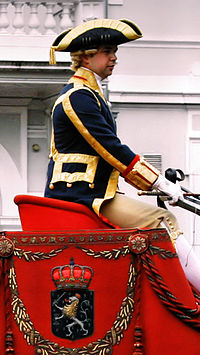
Individual rulers differed greatly in tastes and interests, as well as in political skills and in constitutional situations. Accordingly, some founded elaborate courts based on newpalaces,only to have their successors retreat to remotecastlesor to practical administrative centers. Personal retreats might arise far away from official court centres.
Etiquetteandhierarchyflourish in highly structured court settings, and may leave conservative traces over generations. Most courts featured a strictorder of precedence,often involvingimperial, royal and noble ranks,orders of chivalry,andnobility.Some courts even featuredcourt uniforms.One of the major markers of a court isceremony.Most monarchal courts included ceremonies concerning theinvestitureorcoronationof themonarchandaudienceswith the monarch. Some courts had ceremonies around the waking and the sleeping of the monarch, called alevée.Orders of chivalryas honorific orders became an important part of court culture starting in the 15th century.[1]They were the right of themonarch,as thefount of honour,to create and grant.
History
[edit]Early history
[edit]The earliest developed courts were probably in theAkkadian Empire,Ancient Egypt,andShang dynasty.However, there is evidence of courts as described in theNeo-Assyrian Empire[2]andZhou dynasty.[3]Two of the earliest titles referring to the concept of a courtier were likely theša rēsiandmazzāz pāniof the Neo-Assyrian Empire.[4]In Ancient Egypt, there is a title translated ashigh stewardor great overseer of the house.[5]The royal courts influenced by the court of the Neo-Assyrian Empire such as those of theMedian Empireand theAchaemenid Empirewould also have identifiable developed courts withcourt appointmentsand other features associated with later courts.[6]
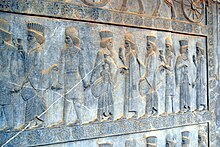
The imperial court of the Achaemenid Empire atPersepolisandPasargadaeis the earliest identifiable complex court with all of the definitive features of a royal court such as a household,court appointments,courtiers, and court ceremony.[8]ThoughAlexander the Greathad an entourage and the rudimentary elements of a court, it was not until after he conquered Persia that he took many of the more complex Achaemenid court customs back to theKingdom of Macedonia,developing a royal court that would later influence the courts ofHellenistic Greeceand theRoman Empire.[9]
TheSasanian Empireadopting and developing the earlier court culture and customs of the Achaemenid Empire would also influence again the development of the complex court and court customs of the Roman Empire andByzantine Empire.[10]
Theimperial courtof the Byzantine Empire atConstantinoplewould eventually contain at least a thousand courtiers.[11]The court's systems became prevalent in other courts such as those in theBalkanstates, theOttoman Empire,andRussia.[12]Byzantinismis a term that was coined for this spread of the Byzantine system in the 19th century.[13]

East Asia
[edit]The imperial courts ofChinese emperors,known ascháotíng(Triều đình), were among the largest and most complex of all. TheHan dynasty,Western Jin dynasty,andTang dynastyoccupied the large palace complex atWeiyang Palacelocated nearChang'an,and the laterMing dynastyandQing dynastyoccupied the wholeForbidden Cityand other parts ofBeijing,the present capital city ofChina.By theSui dynasty,the functions of the imperial household and the imperial government were clearly divided.
During theHeian period,Japanese emperorsandtheir familiesdeveloped an exquisitely refined court that played an important role in their culture.
Medieval and modern Europe
[edit]After the collapse of theRoman Empirein the West, a true court culture can be recognised in the entourage of theOstrogothTheodoric the Greatand in the court ofCharlemagne.In the Roman East, a brilliant court continued to surround theByzantine emperors.
InWestern Europe,consolidation of power of local magnates and of kings in fixed administrative centres from the mid-13th century led to the creation of a distinct court culture that was the centre of intellectual and artistic patronage rivaling theabbotsandbishops,in addition to its role as the apex of a rudimentary political bureaucracy that rivaled the courts of counts and dukes. The dynamics of hierarchy welded the court cultures together. Many early courts in Western Europe wereitinerant courtsthat traveled from place to place.
Local courts proliferated in the splintered polities ofmedieval Europeand remained inearly modern timesin Germany and in Italy. Such courts became known for intrigue andpower politics;some also gained prominence as centres and collective patrons ofartandculture.In medieval Spain (Castile), provincial courts were created. Minor noblemen andburguesieallied to create a system to oppose the monarchy on many policy issues. They were called "las Cortes de Castilla". These courts are the root of the current Spanishcongressandsenate.
The courts ofValois Burgundyand theKingdom of Portugalwere particularly influential over the development of court culture and pageantry in Europe. The court ofPhilip the Good,Duke of Burgundywas considered one of the most splendid in Europe and would influence the development of court life later on for all of France and Europe.[14]Later,Aliénor de Poitiersof the Burgundian court would write one of the seminal books on court etiquette,Les honneurs de la cour(Honours of the Court).
Court life would reach its apogee of culture, complexity and etiquette at the courts ofVersaillesunderLouis XIV of Franceand theHofburgunder theHabsburgs.
Aspolitical executivefunctions are assumed bydemocraticorrepublicaninstitutions, the function of noble courts is reduced once more to that of noble households, concentrating on personal service to the household head,ceremonialand perhaps some residual politico-advisory functions. Ifrepublicanzeal has banished an area's erstwhile rulingnobility,courts may survive inexile.Traces of royal court practices remain in present-day institutions like privy councils and governmental cabinets.
Africa
[edit]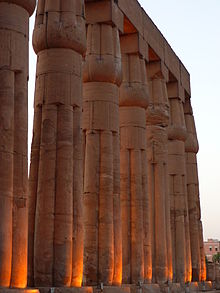
A series ofPharaohsruledAncient Egyptover the course of three millennia (c. 3150 BCto 31 BC), until it was conquered by theRoman Empire.In the same time period several kingdoms with their own royal courts flourished in the nearbyNubiaregion, with at least one of them, that of the so-calledA-Groupculture, apparently influencing the customs of Egypt itself. From the 6th to 19th centuries, Egypt was variously part of theByzantine Empire,Islamic Empire,MamlukSultanate,Ottoman EmpireandBritish Empirewith a distant monarch. TheSultanate of Egyptwas a short lived protectorate of theUnited Kingdomfrom 1914 until 1922, when it became theKingdom of Egyptand SultanFuad Ichanged his title to King. After theEgyptian Revolution of 1952the monarchy was dissolved and Egypt became a republic.
In theHorn of Africa,theKingdom of Aksumand later theZagwe dynasty,Ethiopian Empire(1270–1974), andAussa Sultanateall had royal courts. VariousSomali Sultanatesalso existed, including theAdal Sultanate(led by theWalashma dynastyof theIfat Sultanate),Sultanate of Mogadishu,Ajuran Sultanate,Warsangali Sultanate,Geledi Sultanate,Majeerteen SultanateandSultanate of Hobyo.
The kingship system has been an integral part of the more centralised African societies for millennia. This is especially true in theWest African sahel,where royal courts have been in existence since at least the era of the 9th centuryTakrurandGhana empires.The ruler of the 13th centuryMali empire,Mansa Musa,brought a large number of his courtiers with him on the IslamicHajjpilgrimage toMecca.Today, the courts of theAshantinanasin modernGhana,theMandemembers of theTunkalemmucaste in Mali, theBamumsultansofCameroon,theKanemshaykhsofChad,theHausaemirsof northernNigeria,theinkosisof theSouthern AfricanZulusandXhosas,and theobasandbaalesofYorubaland,amongst others, continue the pageantry and court lifestyle traditions once common to the continent.
Americas
[edit]Court structure and organization
[edit]Court officials
[edit]
Court officials or office-bearers (one type ofcourtier) derived their positions and retained their titles from their original duties within the courtly household. With time, such duties often became archaic. However, titles survived involving the ghosts of arcane duties. These styles generally dated back to the days when a noble household had practical and mundane concerns as well as high politics and culture. Suchcourt appointmentseach have their own histories. They might include but are not limited to:
- Almoner
- Butler
- Chamberlain
- Chancellor
- Chapelmaster
- Chaplain
- Cofferer
- Confessor
- Constable
- Cup-bearer
- Dapifer
- Doorward
- Eunuch
- Falconer
- Gentleman of the Bedchamber
- Gentleman Usher
- Grandmaster
- Great officers
- Groom of the Stool
- Herald
- Intendant
- The Royal Fool
- Keeper of the seal
- King of arms
- Knight/Earl Marshal
- Lady-in-waiting
- Maid of Honour
- Majordomo
- Master of Ceremonies
- Master of the Horse
- Master of the Hunt
- Page
- PanterorGrand Panetier
- Secretary
- Pursuivant
- Seneschal
- Stolnik
- Standard bearer
- Steward
Court seats
[edit]Earlier courts in medieval Western Europe wereitinerant courts,but courts were often held in a fixed place. One of the criteria of Norbert Elias' concept of a court society is that it existed in space.[clarification needed][15][page needed]TheGermanwordHof,meaning an enclosedcourtyard,can also apply to a rural farmstead with outbuildings and walls forming the perimeter. It has also been used for thepalatial seatwhere the court was held. ThusHofor "court" can become transferred to the building itself. For example, the grand residenceHampton Court Palaceon theRiver Thamesabove London was whereThomas Wolseyheld court as Catholic cardinal (built after the Italian ideal for a cardinal's palace) until his fall and its confiscation byHenry VIII.William IIIandMary IIalso held court there, 1689–94. Though it is built round two main courts, the structure itself is no longer the seat of a court in the sense of this article.
As an example, ambassadors to the United Kingdom are still accredited to theCourt of St. James's,and courtiers of the monarchy may still have offices inSt James's Palace,London. The present monarch, however, holds court atBuckingham Palace,where dignitaries are received.
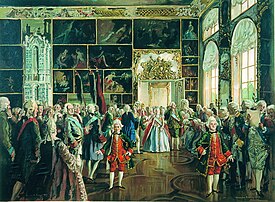

Some former seats of power (seeofficial residence):
- TheHaute Cour(High Court) was the feudal council of theKingdom of Jerusalem.
- Alhambrain Granada, seat of the last Muslim dynasty in current Spain
- Ali Qapu Palace,imperial palace of the laterSafavid emperorsinIsfahan,Iran.
- TheForbidden City,imperial palace complex of theMingandQingdynasties walled off fromBeijing
- Gyeongbokgung Royal Palace,royal palace of theJoseon dynastyinSeoul
- Wawel CastleinKrakówandWarsawRoyal Castle,Poland
- Château de Versaillesnear Paris in France
- Palace of Darius in SusaandPersepolis,imperialAchaemenidpalaces
- Taq-i KisrainCtesiphon,Persia, inSasanianperiod
- Hofburg PalaceinVienna,Austria
- Palatine HillinRome,Italy. Origin of the word palace.
- SanssouciinPotsdamnear Berlin
- Munich ResidenceinMunichinBavaria
- Ludwigsburg PalaceinLudwigsburginSwabia
- Dresden CastleinDresdeninSaxony
- TheVaticanin thePapal States
- Palazzo Medici Riccardi,palace of theHouse of Medici,Grand Dukes of Tuscany
- TheKingdom of Portugal
- The Royal Alcáçova ofCoimbra– under theHouse of Burgundy
- TheRoyal Alcáçova of São Jorge,Lisbon– under the houses ofBurgundyandAviz
- TheRoyal Palace of Évora– under the reign ofManuel I of Portugal
- TheRoyal Palace of Sintra– under the reigns ofManuel I of PortugalandJohn III of Portugal
- ThePalaces of Ribeira,Lisbon– under the Houses ofAviz,Habsburg,andBraganza
- ThePalace of Ajuda,Lisbon– under theHouse of Braganza
- Urbino,seat of a duchy in theMarche
- TheRed Fort,palatial fortress of theMughal emperorsinDelhi,India
- Shaniwar Wadapalace fort of theMaratha PeshwasinPune,India
- Great Palace of ConstantinopleinConstantinople
- Topkapı PalaceinIstanbul,Turkey– under theOttoman dynasty
- Winter PalaceinSaint Petersburg,Russia
- Royal Palace of MadridinSpain
- Alcázar de ColóninSanto Domingo
Court structure and titles
[edit]- Byzantine aristocracy and bureaucracyin theByzantine Empire
- Ethiopian aristocratic and court titles
- Government of the Han dynasty
- Imperial Household AgencyinJapan
- Itinerant courtin European kingdoms in theEarly Middle Ages.
- Maison du RoiinFranceduring theAncien Régime
- Ministry of the Imperial CourtinImperial Russia
- Papal Courtof theHoly See
- Royal Court of SwedeninSweden
- Royal Household and Heritage of the Crown of SpaininSpain
- Royal Households of the United Kingdomin theUnited Kingdom
- Titles of the Welsh CourtinWalesduring theMiddle Ages
Caliphate courts
[edit]All four majorCaliphateshad sophisticatedcourts;this enabledCordoba,CairoandBaghdad(the respective seats of theOmayyad,theFatimidand theAbbasid) to become the largest, most culturally developed cities of their time. This drew talented people from all walks of life—such asmusicians,singers,poetsandscientists—to seek employment under the patronage of elitebureaucrats,emirsandSultansat court. The otherCaliphatewas theOttoman,which employed its court's culture to stabilize an empire inhabited by huge non-Islamic populations spanning threecontinents.Everything fromAlgeriato theBalkanstoYemenwas controlled by the court inIstanbul.
The royal courts in theIslamic worldwere mostly run by rulers, but there were the exceptions of important elite families such asBarmakidsandNizamswho established their own minor courts, enabling them to encourage arts and improve the empire even if the ruling king was useless.
See also
[edit]- Aliénor de Poitiers,who documented the etiquette of the Burgundian Court in the late 15th century
- Court appointment
- Courtesy book
- Curia regis
- Masque
- Orda (organization),the nomadic court of theTurkicandMongolpeoples
- Striking in the King's Court
References
[edit]- ^Velde, François Velde (25 February 2004)."Legitimacy and Orders of Knighthood".Heraldica.Retrieved25 February2015.
- ^Radner, Karen(22 September 2011).The Oxford Handbook of Cuneiform Culture.Oxford, UK: Oxford University Press. pp. 358–379.ISBN978-0-19-955730-1.
- ^ChinaKnowledge.de encyclopedia,"Chinese History - Zhou dynasty government and administration".Archived fromthe originalon 2013-05-31.Retrieved2012-12-07..Alternatively, the sequence was translated asprince, lord, elder, master, chieftain:Brooks 1997:3 n.9.
- ^Groß, Melanie; Pirngruber, Reinhard (September 2014)."On Courtiers in the Neo-Assyrian Empire: ša rēsi and mazzāz pāni"(PDF).Imperium and Officium Working Papers (IOWP).Retrieved24 February2015.
- ^Stephen Quirke:Titles and bureaux of Egypt 1850–1700 BC,London 2004,ISBN0-9547218-0-2,pp. 50–51, 61
- ^Dandamayev, Muhammad."COURTS AND COURTIERS i. In the Median and Achaemenid periods".Encyclopædia Iranica.Retrieved24 February2015.
- ^electricpulp.com."PERSEPOLIS – Encyclopaedia Iranica".www.iranicaonline.org.Retrieved19 March2018.
- ^Brosius, Maria (2007). "New out of old? Court and court ceremonies in Achaemenid Persia". In Spawforth, A. J. S. (ed.).The Court and Court Society in Ancient Monarchies.Cambridge UK: Cambridge University Press. pp. 1–57.ISBN978-0-521-87448-9.
- ^Spawforth, Tony (2007). "The court of Alexander the Great between Europe and Asia". In Spawforth, A. J. S. (ed.).The Court and Court Society in Ancient Monarchies.Cambridge UK: Cambridge University Press. pp. 93–97.ISBN978-0-521-87448-9.
- ^Canepa, Matthew (2 February 2010).The Two Eyes of the Earth: Art and Ritual of Kingship between Rome and Sasanian Iran.University of California Press.ISBN978-0520257276.
- ^Kazhdan, Alexander P.; McCormick, Michael (1995)."The Social World of the Byzantine Court"(PDF).In Maguire, Henry (ed.).Byzantine Court Culture from 829 to 1204.Harvard University Press. p. 175.ISBN9780884023081.
- ^Angelov, Dimiter G. (2003). "Byzantinism: The Imaginary and Real Heritage of Byzantium in Southeastern Europe".New approaches to Balkan studies.Brassey's. pp. 3, 11.ISBN1574887246.
- ^Angelov, Dimiter G. (2003). "Byzantinism: The Imaginary and Real Heritage of Byzantium in Southeastern Europe".New approaches to Balkan studies.Brassey's. p. 8.ISBN1574887246.
- ^Oosterwijk, A Van (1 February 2013).Staging the Court of Burgundy (Studies in Medieval and Early Renaissance Art History).Brepols Publishers.ISBN978-1905375820.
- ^Elias 1983.
Bibliography
[edit]- Elias, Norbert(1983) [1969].The Court Society[Die höfische Gesellschaft]. trans. Edmund Jephcott. Oxford.
{{cite book}}:CS1 maint: location missing publisher (link)On the sociology of the court, originally completed in 1939. - Fox, Robin Lane (1973).Alexander the Great.
Further reading
[edit]Antiquity
[edit]- Spawforth, A. J. S. (ed.).The Court and Court Society in Ancient Monarchies.Cambridge, 2007
Middle Ages
[edit]- Branner, Robert, et al., eds.Art and the Courts: France and England from 1259 to 1328,2 vols. Ottawa, 1972.
- Bumke, Joachim.Courtly Culture: Literature and Society in the High Middle Ages.Berkeley and Ozford, 1991.
- Cubitt, C. (ed.).Court Culture in the Early Middle Ages. The Proceedings of the First Alcuin Conference.Turnhout, 2002
- Hen, Yitzhak.Roman Barbarians: The Royal Court and Culture in the Early Medieval West.Basingstoke: Palgrave Macmillan, 2007.ISBN978-0-333-78665-9.
- Jaeger, C.S.The Origins of Courtliness: Civilizing Trends and the Formation of Courtly Ideals 939–1210.Philadelphia, 1985.
- Jones, S.R., R. Marks and A. J. Minnis (eds.).Courts and Regions in Medieval Europe.York, 2000.
- Jong, M. de and F. Theuws (eds.).Topographies of Power in the Early Middle Ages.Leiden, 2001.
- Scaglione, A.Knights at Court: Courtliness, Chivalry, and Courtesy from Ottonian Germany to the Italian Renaissance.LA and Oxford, 1991.
- Scattergood, V.J.English Court Culture in the Later Middle Ages.London, 1983.
- Vale, Malcolm.The Princely Court: Medieval Courts and Culture in North-West Europe.Oxford: Oxford University Press, 2001.
Renaissance and Early Modern
[edit]- Adamson, John (ed.).The Princely Courts of Europe, 1500–1750. Ritual, Politics and Culture under the Ancien Régime, 1500–1750.London, 1999.
- Asch, Ronald G., and Adolf M. Birke, eds.Princes, Patronage and the Nobility: The Court at the Beginning of the Modern Age, c.1450–1650.London and Oxford, 1991.
- Birke, A., and R. Asch (eds.).Courts, Patronage and the Nobility at the Beginning of the Modern Period, 1450–1650.1991.
- Burke, Peter.The Fabrication of Louis XIV.New Haven and London, 1992.
- Charles-Edwards, T.M. et al.The Welsh king and his court.Cardiff, 2000.
- Dickens, A.G. (ed.).The Courts of Europe: Politics, Patronage and Royalty, 1400–1800.1977. Emphasis on patronage.
- Duindam, Jeroen.Myths of Power: Norbert Elias and the Early Modern European Court.Amsterdam, 1995. Critique of Elias. English translation of dissertationMacht en Mythe(1992).
- Duindam, Jeroen.Vienna and Versailles. The courts of Europe's Dynastic Rivals 1550–1780.Cambridge, 2003.
- Elias, Norbert.The Court Society.Oxford, 1983.
External links
[edit]- "Bibliography of Early Modern courts 1580–1700, structure and patronage"(PDF).Oxford University.2002.
- "Court culture: representations of intimacy".Oneonta.edu.Division between Hall and Chamber in late medieval noble and royal households.
- Herbermann, Charles, ed. (1913)..Catholic Encyclopedia.New York: Robert Appleton Company.
- "The Society for Court Studies".Courtstudies.org.Bibliography on court history.
